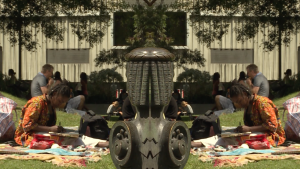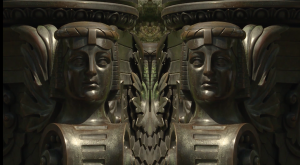I had written about the abstract vision exercise Gabe and I did in week two in another blog post where I mainly discussed the technical process of shooting. Here I want to talk about the editing of these abstract shots and the abstract sounds I recorded with Annick.
At first I just started playing around, seeing how various shots would cut together in different orders. There seemed to be no clear unity between the shots, so I began to try to connect them through different effects. I created a split screen mirror effect and repeated the same shot in different ways. I also tried to colour grade the clips similarly (the most obvious being the black and white filter). My favourite edit is the cut between the ‘two-headed’ statue and the reverse shot of where the statue is ‘looking’.


Prior to creating a split screen effect there seemed to be no purpose to the shot; but when I changed the position of the statue in the frame it seemed to link the two shots like a traditional shot-reverse-shot continuous edit.
I also experimented with an effect I learnt last semester called time splicing where you crop a frame into separate columns, layer the separate clips of the same shot on top of each other in your editing time line and then methodically move each clip a couple of frames later than the one before. The clip I was using didn’t feature much movement, but I realised that when there was movement across the whole frame it created an interesting rhythmic effect where the action slowly transferred from one column to the next. This is an exercise I would like to investigate more throughout the semester.

After listening back over my abstract sound recordings I decided to only use the sounds I really liked, which limited the amount of layering I was able to do with the audio tracks (because I only liked two of the recordings we got). Instead of going for a realistic soundscape I decided to go for something more abstract. I used the recording of a pedestrian-crossing to juxtapose the nature shots we filmed (for example the shot of the spider web). I then used the intense sound of a water fountain to layer over the vision of a man-made statue.
This week I discovered the importance of playing around in post production, because there is so much more you can do with vision and sound when you aren’t limited to creating something that looks continuous or realistic.
